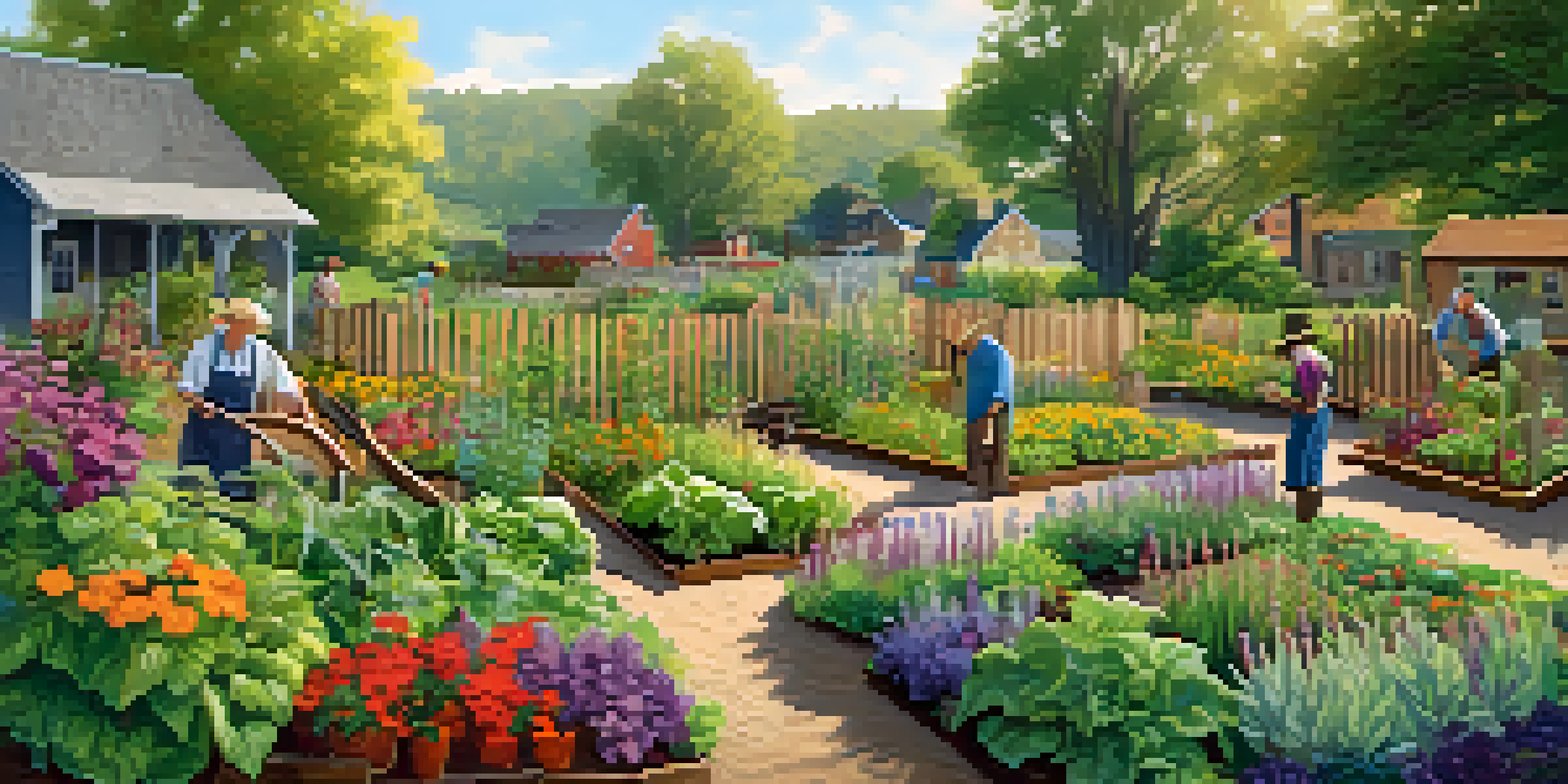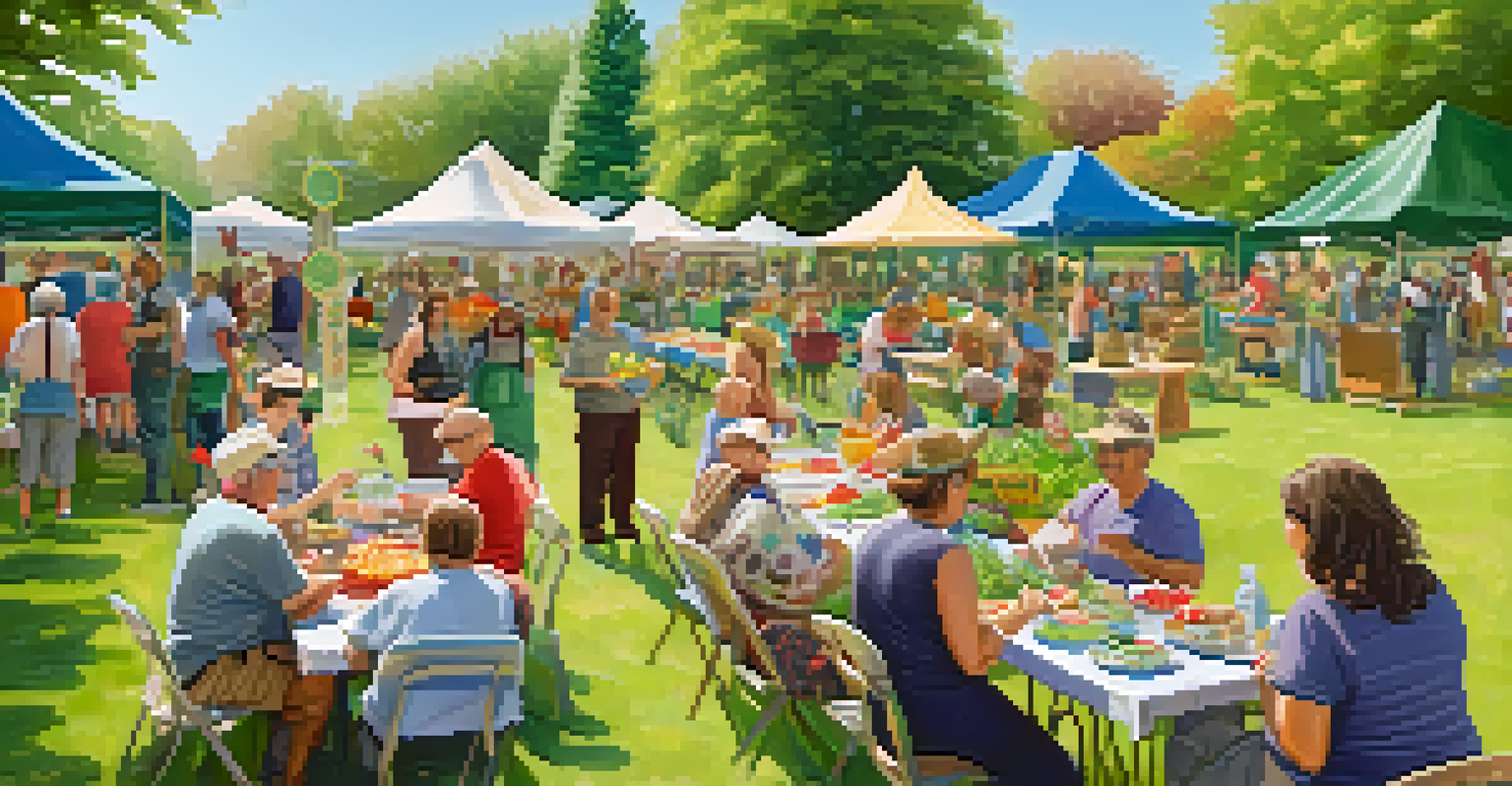Getting Started with Community Gardening: A Beginner's Guide

Understanding the Basics of Community Gardening
Community gardening is about growing plants collaboratively in shared spaces, typically in urban settings. It brings together individuals from diverse backgrounds, fostering a sense of community while also promoting sustainability. This practice can range from small backyard plots to larger public spaces where neighbors unite to cultivate flowers, vegetables, and herbs.
To forget how to dig the earth and to tend the soil is to forget ourselves.
For beginners, community gardening can feel a bit daunting, but it’s all about learning and sharing experiences. Think of it as a potluck for gardening, where everyone brings their knowledge and enthusiasm to the table. The beauty of this approach is that you learn from each other, making it a rich educational experience.
As you dive into community gardening, remember that it’s not just about the plants; it’s also about building relationships. Engaging with fellow gardeners can create a supportive network, turning gardening into a social activity that enhances your local environment and personal well-being.
Choosing the Right Community Garden for You
Finding the right community garden can significantly impact your experience. Begin by exploring local options through community centers, social media, or gardening websites. Look for gardens that align with your interests, whether that’s growing vegetables, flowers, or even participating in educational workshops.

Consider factors such as location, accessibility, and the rules of the garden. Some gardens may require a membership fee or have specific guidelines on what you can plant. It’s essential to choose a space that feels welcoming and fits your lifestyle, so you can enjoy your gardening journey.
Community Gardening Builds Connections
Engaging in community gardening fosters relationships and creates a supportive network among participants.
Once you find a garden that resonates with you, reach out to the coordinators or existing members. They can provide insights about the community and any ongoing projects. This initial connection can make you feel more at ease and excited about joining the gardening adventure.
Essential Tools for Beginner Community Gardeners
Equipping yourself with the right tools is crucial for a successful gardening experience. As a beginner, you don’t need to invest in an elaborate toolkit; a few essential items will suffice. Start with a hand trowel, pruning shears, gloves, and a watering can.
Gardening is the purest of human pleasures.
These basic tools will help you plant, maintain, and harvest your crops effectively. Think of this toolkit as your gardening starter pack, providing you with the necessary gear to tackle various gardening tasks. As you gain experience, you may want to expand your collection with items like a garden fork or a weeder.
Don’t forget about the importance of good-quality seeds or seedlings. Choosing the right plants for your garden is critical, so consider local climate conditions and seasonal timing. It’s also helpful to ask veteran gardeners for recommendations on which plants thrive in your area.
Understanding Planting Seasons and Local Climate
Every gardener must understand the significance of planting seasons and climate in their area. Knowing when to plant is crucial for the success of your garden. Generally, spring is the most popular time for planting, but some plants can be sown in late summer or even fall.
Start by researching your local growing zone, which indicates the best plants suited for your climate. This information is like a roadmap, guiding you through the types of vegetables and flowers that will thrive in your community garden. Resources like local gardening clubs or extension services can provide valuable insights.
Essential Tools Enhance Gardening
Having the right basic tools is crucial for beginners to effectively plant, maintain, and enjoy their gardening experience.
Additionally, pay attention to your garden's microclimate. Factors like sunlight, shade, and wind patterns can vary even within the same neighborhood. Observing these elements will help you make informed decisions about what to plant and where, ensuring your garden flourishes.
Building Community and Social Connections
One of the most rewarding aspects of community gardening is the opportunity to connect with others. Gardening is often seen as a solitary activity, but in a community garden, you have the chance to collaborate and socialize. Sharing your gardening journey with others can lead to lasting friendships and a supportive environment.
Participating in garden events such as potlucks, workshops, or clean-up days can enhance your experience. These gatherings provide a platform to exchange ideas, learn new techniques, and celebrate your gardening achievements together. Think of these events as community-building exercises that strengthen bonds among fellow gardeners.
As you engage with your gardening community, don’t hesitate to share your own experiences and insights. Offering help or advice to others can create a sense of belonging and contribute to a positive atmosphere. Remember, every gardener has something valuable to share, and your unique perspective can enrich the collective knowledge.
Learning About Sustainable Gardening Practices
Sustainable gardening practices are essential for preserving the environment and ensuring the health of your garden. As a beginner, you can start by learning about organic gardening methods, such as composting and natural pest control. These practices not only benefit your garden but also contribute to the well-being of the planet.
Composting is a fantastic way to recycle kitchen scraps and yard waste, turning them into nutrient-rich soil. It’s like giving your garden a nutritious meal, enhancing the growth of your plants. Many community gardens even have shared compost bins, allowing everyone to participate in this eco-friendly practice.
Sustainable Practices Benefit All
Implementing sustainable gardening methods, like composting and using native plants, supports both the environment and garden health.
Additionally, consider using native plants in your garden. These plants are adapted to your local environment and require less water and maintenance. By choosing native species, you’re supporting local ecosystems and creating habitats for beneficial insects and wildlife. Sustainable gardening is a win-win, making your garden both beautiful and environmentally friendly.
Celebrating Your Gardening Achievements
As you embark on your community gardening journey, take time to celebrate your achievements, no matter how small. Harvesting your first crop is a significant milestone that deserves recognition. Share your successes with fellow gardeners, as their encouragement can deepen your connection to the community.
Consider keeping a gardening journal to document your experiences, challenges, and triumphs. This practice can help you reflect on your growth as a gardener and track the progress of your plants over time. Plus, it serves as a wonderful keepsake that captures your gardening journey.

Organizing a garden party or harvest celebration is another fantastic way to acknowledge your hard work. Invite friends, family, and fellow gardeners to enjoy the fruits of your labor together. Celebrating your achievements fosters a sense of pride and camaraderie, making your community gardening experience even more enjoyable.